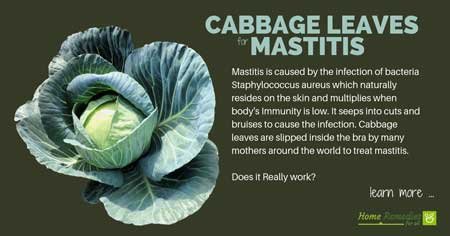Mastitis or breast infection is common among first time breastfeeding mothers. If you already had once, then your risk of mastitis is higher after the subsequent child births in the future. It occurs when your immunity is low for some reason.
Mastitis is caused by a bacteria Staphylococcus aureus which enters the breast through minor cuts and bruises. Pain, swelling, hard lump fever and nipple discharge are the main symptoms. It can turn to thrush for both the mother and child if not immediately treated.
You can reduce pain and swelling by hot compress and get rid of infection with topical application of cabbage leaves. All colors are good so use whichever you prefer, though purple red cabbage is slightly more potent than other colors.
Table of Contents
- How Effective are Cabbage Leaves to Treat Mastitis and Why?
- How to Use Cabbage Leaves for Mastitis
- Additional Remedies for Mastitis at Home
- Other Tips and Precautions
How Effective are Cabbage Leaves to Treat Mastitis and Why?
Cabbage leaves are slipped inside the bra by many mothers around the world to treat mastitis. There is not much scientific research available but it is believed that certain anti- inflammatory and antibacterial nutrients and enzymes in the cabbage are responsible to get rid of the breast inflammations, pain and infection.
Mastitis is caused by the infection of bacteria Staphylococcus aureus which naturally resides on the skin and multiplies when the body's Immunity is low. It seeps into cuts and bruises to cause the infection.
Symptoms of mastitis are as under:
- Breast tenderness and can be warm to the touch
- Redness of skin
Swelling/engorgement - Hard lumps in breast in most cases
- Fever and chills
- Discomfort during breastfeeding
A large number of anti-inflammatory and antioxidants are found in almost all kinds of cabbages ranging from white, great, red to dark purple.
The red cabbage has the highest amount of flavonoids anthocyanins which are good anti-inflammatory compounds.
Other polyphenols that provide anti-inflammatory capabilities in cabbage are artemetin, betanidin, butein, equol, hydroxyflavone, kaempferol, luteolin, malvidin, naringenin, pelargonidin, purpurogallin, quercitol, and tetrahydroxy chalcone.
Various studies have shown antibacterial capabilities of sulphur compounds found in cabbage. They include sinigrin, allyl isothiocyanate (AITC), methyl methanethiosulfinate (MMTSO), dimethyl sulfide (DMS), methyl methanethiosulfonate (MMTSOz). S-methyl-L-cysteine sulfoxide (SMCSO), dimethyl disulfide (DMDS) and dimethyl trisulfide (DMTS).
With both anti-inflammatory capabilities to reduce swelling, pain and inflammation and antibacterial capabilities to fight infection, cabbage is a worth trying home remedy for mastitis.
If cabbage leaves or other home remedies don't heal your breast infection then you must consult your doctor and fix the problem.
How to Use Cabbage Leaves for Mastitis
Generally cold cabbage leaves are wrapped around the infected breast to get rid of inflammation pain and infection.
Do it as under:
- Take a fresh cabbage and discard any damaged leaves from the top layer
- Keep it in refrigerator for 10-15 minutes ( don't put it in deep freezer)
- Take out the cabbage from the fridge
- Remove one or two leaves again from top layer and discard.
- Now take two leaves and remove their stems.
- Place the pieces on the affected breast leaving the nipple to cover the entire breast
- Put on your bra to hold cabbage leaves in place
- Leave it for 15 - 20 minutes and remove
- Apply warm compress
- Do it 2-3 time every day until the infection is gone
When you begin to feel the relief stop using cabbage leaves. Cold compress generally reduces milk supply. So overdoing it is not recommended.
Additional Remedies for Mastitis at Home
Following simple practices will help in mastitis
- Apply warm compress before breastfeeding to improve milk flow
- Massage your affected breast towards nipple during and in between breastfeeding for continuous milk supply
- Stay fully hydrated by drinking enough water. It helps in maintaining high immunity
Other Tips and Precautions
You can prevent mastitis and other breastfeeding problems if you take the following precautions.
- Make sure the child latches the breast completely. Shallow latch can cause low drainage of milk leading to engorgement.
- Wear good quality comfortable bra which is not too tight.
- Breastfeed often to ensure milk is drained from the breasts.
- Eat healthy nourishing diet
- Take sufficient rest
Mastitis is a preventable condition but if it occurs then tackle it immediately at home. If home remedies don't work then take medical help.

